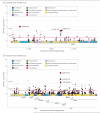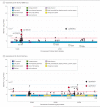Association of Brain DNA methylation in SORL1, ABCA7, HLA-DRB5, SLC24A4, and BIN1 with pathological diagnosis of Alzheimer disease
- PMID: 25365775
- PMCID: PMC4344367
- DOI: 10.1001/jamaneurol.2014.3049
Association of Brain DNA methylation in SORL1, ABCA7, HLA-DRB5, SLC24A4, and BIN1 with pathological diagnosis of Alzheimer disease
Abstract
Importance: Recent large-scale genome-wide association studies have discovered several genetic variants associated with Alzheimer disease (AD); however, the extent to which DNA methylation in these AD loci contributes to the disease susceptibility remains unknown.
Objective: To examine the association of brain DNA methylation in 28 reported AD loci with AD pathologies.
Design, setting, and participants: Ongoing community-based clinical pathological cohort studies of aging and dementia (the Religious Orders Study and the Rush Memory and Aging Project) among 740 autopsied participants 66.0 to 108.3 years old.
Exposures: DNA methylation levels at individual CpG sites generated from dorsolateral prefrontal cortex tissue using a bead assay.
Main outcomes and measures: Pathological diagnosis of AD by National Institute on Aging-Reagan criteria following a standard postmortem examination.
Results: Overall, 447 participants (60.4%) met the criteria for pathological diagnosis of AD. Brain DNA methylation in SORL1, ABCA7, HLA-DRB5, SLC24A4, and BIN1 was associated with pathological AD. The association was robustly retained after replacing the binary trait of pathological AD with 2 quantitative and molecular specific hallmarks of AD, namely, Aβ load and paired helical filament tau tangle density. Furthermore, RNA expression of transcripts of SORL1 and ABCA7 was associated with paired helical filament tau tangle density, and the expression of BIN1 was associated with Aβ load.
Conclusions and relevance: Brain DNA methylation in multiple AD loci is associated with AD pathologies. The results provide further evidence that disruption of DNA methylation is involved in the pathological process of AD.
Figures




Comment in
-
Exploring the epigenetics of Alzheimer disease.JAMA Neurol. 2015 Jan;72(1):8-9. doi: 10.1001/jamaneurol.2014.3057. JAMA Neurol. 2015. PMID: 25365705 Free PMC article. No abstract available.
Similar articles
-
Exploring the epigenetics of Alzheimer disease.JAMA Neurol. 2015 Jan;72(1):8-9. doi: 10.1001/jamaneurol.2014.3057. JAMA Neurol. 2015. PMID: 25365705 Free PMC article. No abstract available.
-
Leukocyte DNA methylation in Alzheimer´s disease associated genes: replication of findings from neuronal cells.Epigenetics. 2023 Dec;18(1):2158285. doi: 10.1080/15592294.2022.2158285. Epub 2022 Dec 26. Epigenetics. 2023. PMID: 36573011 Free PMC article.
-
Alzheimer's disease: early alterations in brain DNA methylation at ANK1, BIN1, RHBDF2 and other loci.Nat Neurosci. 2014 Sep;17(9):1156-63. doi: 10.1038/nn.3786. Epub 2014 Aug 17. Nat Neurosci. 2014. PMID: 25129075 Free PMC article.
-
SORL1 genetic variants and Alzheimer disease risk: a literature review and meta-analysis of sequencing data.Acta Neuropathol. 2019 Aug;138(2):173-186. doi: 10.1007/s00401-019-01991-4. Epub 2019 Mar 25. Acta Neuropathol. 2019. PMID: 30911827 Review.
-
Challenge accepted: uncovering the role of rare genetic variants in Alzheimer's disease.Mol Neurodegener. 2022 Jan 9;17(1):3. doi: 10.1186/s13024-021-00505-9. Mol Neurodegener. 2022. PMID: 35000612 Free PMC article. Review.
Cited by
-
Changes in DNA methylation over the growing season differ between North Carolina farmworkers and non-farmworkers.Int Arch Occup Environ Health. 2016 Oct;89(7):1103-10. doi: 10.1007/s00420-016-1148-0. Epub 2016 Jun 27. Int Arch Occup Environ Health. 2016. PMID: 27349971 Free PMC article.
-
Influence of Coding Variability in APP-Aβ Metabolism Genes in Sporadic Alzheimer's Disease.PLoS One. 2016 Jun 1;11(6):e0150079. doi: 10.1371/journal.pone.0150079. eCollection 2016. PLoS One. 2016. PMID: 27249223 Free PMC article.
-
Synonymous variants associated with Alzheimer disease in multiplex families.Neurol Genet. 2020 Jun 8;6(4):e450. doi: 10.1212/NXG.0000000000000450. eCollection 2020 Aug. Neurol Genet. 2020. PMID: 32637632 Free PMC article.
-
ATP-binding cassette transporter A7 (ABCA7) loss of function alters Alzheimer amyloid processing.J Biol Chem. 2015 Oct 2;290(40):24152-65. doi: 10.1074/jbc.M115.655076. Epub 2015 Aug 10. J Biol Chem. 2015. PMID: 26260791 Free PMC article.
-
Estrogen Receptor Genes, Cognitive Decline, and Alzheimer Disease.Neurology. 2023 Apr 4;100(14):e1474-e1487. doi: 10.1212/WNL.0000000000206833. Epub 2023 Jan 25. Neurology. 2023. PMID: 36697247 Free PMC article.
References
-
- Gatz M, Pedersen NL, Berg S, et al. Heritability for Alzheimer's disease: the study of dementia in Swedish twins. J Gerontol A Biol Sci Med Sci. 1997;52(2):M117–M125. - PubMed
-
- Lambert JC, Heath S, Even G, et al. European Alzheimer's Disease Initiative Investigators. Genome-wide association study identifies variants at CLU and CR1 associated with Alzheimer’s disease. Nat Genet. 2009;41(10):1094–1099. - PubMed
Publication types
MeSH terms
Substances
Grants and funding
- RF1 AG015819/AG/NIA NIH HHS/United States
- R01AG36836/AG/NIA NIH HHS/United States
- K25 AG041906/AG/NIA NIH HHS/United States
- R01AG36042/AG/NIA NIH HHS/United States
- U01AG46152/AG/NIA NIH HHS/United States
- P30AG10161/AG/NIA NIH HHS/United States
- RF1 AG036042/AG/NIA NIH HHS/United States
- U01 AG046152/AG/NIA NIH HHS/United States
- R01 AG017917/AG/NIA NIH HHS/United States
- R01AG17917/AG/NIA NIH HHS/United States
- R01 AG036042/AG/NIA NIH HHS/United States
- P30 AG010161/AG/NIA NIH HHS/United States
- R01AG15819/AG/NIA NIH HHS/United States
- R01 AG041797/AG/NIA NIH HHS/United States
- R01 AG036836/AG/NIA NIH HHS/United States
- R01 AG015819/AG/NIA NIH HHS/United States
LinkOut - more resources
Full Text Sources
Other Literature Sources
Medical
Research Materials
Miscellaneous

